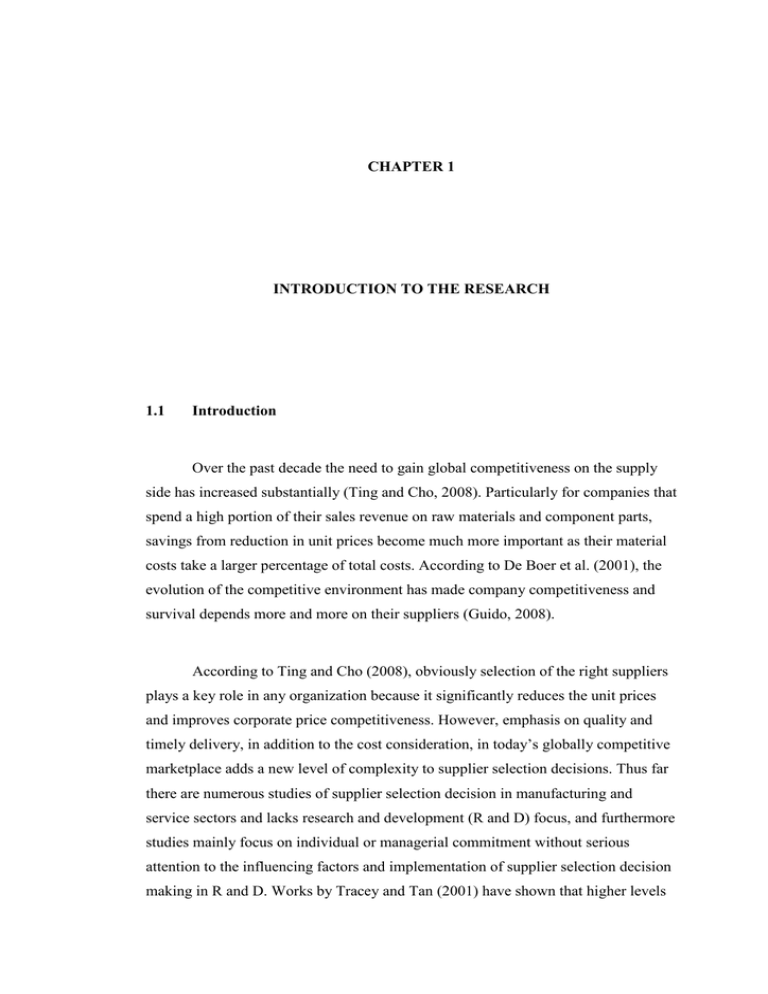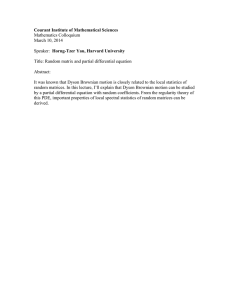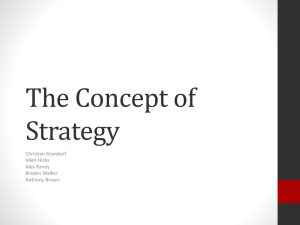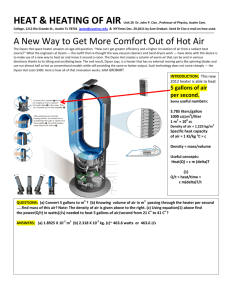CHAPTER 1 INTRODUCTION TO THE RESEARCH 1.1
advertisement

CHAPTER 1 INTRODUCTION TO THE RESEARCH 1.1 Introduction Over the past decade the need to gain global competitiveness on the supply side has increased substantially (Ting and Cho, 2008). Particularly for companies that spend a high portion of their sales revenue on raw materials and component parts, savings from reduction in unit prices become much more important as their material costs take a larger percentage of total costs. According to De Boer et al. (2001), the evolution of the competitive environment has made company competitiveness and survival depends more and more on their suppliers (Guido, 2008). According to Ting and Cho (2008), obviously selection of the right suppliers plays a key role in any organization because it significantly reduces the unit prices and improves corporate price competitiveness. However, emphasis on quality and timely delivery, in addition to the cost consideration, in today’s globally competitive marketplace adds a new level of complexity to supplier selection decisions. Thus far there are numerous studies of supplier selection decision in manufacturing and service sectors and lacks research and development (R and D) focus, and furthermore studies mainly focus on individual or managerial commitment without serious attention to the influencing factors and implementation of supplier selection decision making in R and D. Works by Tracey and Tan (2001) have shown that higher levels 2 of customer satisfaction and firm performance results from selecting and evaluating suppliers based on their ability to provide quality components and subassemblies, reliable delivery and product performance. They also found that involving suppliers on R and D such as product development and continuous improvement teams has an even greater positive impact on firm performance. Furthermore, according to Vonderembse and Tracey (1999), supplier involvement in product and process design and continuous improvement activities has been shown to have a positive impact on competitive advantage and performance. Research and development, often called R and D, is a scientific investigation that explores the development of new goods and services. “Research” aims to generate knowledge in the hopes that it will help create or improve a product, process or service. “Development” converts research findings or other knowledge into a new or improved product, process or service (Miozzo and Walsh, 2006). However in this research the acronym does not include basic research but includes applied research, engineering, product and process design and development or manufacturing R and D. Manufacturing R and D encompasses various activities of product development such as generating new ideas and technologies, design, defining specifications, Failure Mode Effect Analysis (FMEA), design quality, tooling, prototyping, testing, manufacturing, supply, planning, marketing and achieving milestones. It involves activities beginning with the perception of a market opportunity and ending in the production and sale of a product (Mentzer, 2004). R and D is useful for society. It builds up knowledge and it is one of the key inputs for innovation. R and D is considered as a key factor for economic growth, competitiveness and to achieve a higher standard of living. According to Miozzo and Walsh (2006), the capacity of firms to use new technologies is central in explaining industrial leadership and the competitiveness of regions and countries. New product design and development is more than often a crucial factor in the survival of a company. In an industry that is fast changing, firms must continually revise their design and range of products. This is necessary due to continuous technology change and development as well as other competitors and the changing preference of customers. With the introduction and implementation of supplier selection decision 3 making, R and D operations can be supported, improved and help attain the organization’s goals. R and D also contribute to national sustainable growth and therefore should be highly regarded and prioritized. Several critical aspects required consideration prior to the supplier selection. According to Morgan and Monczka (1995), R and D firms have utilized supplier strengths and technologies to support new product development efforts and have drastically reduced supply bases to a handful of certified suppliers. Therefore, buyer need to understand some issues such as pro and cons and make assessment. The decision to place a certain volume of business with a supplier should always be base on a reasonable set of criteria. The art of good purchasing is to make the reasoning behind this decision as sound as possible. Normally, the purchaser’s perception of the supplier ability to meet satisfactory quality, quantity, delivery, price, and service objectives will govern this decision. Some of the more important supplier attributes related to these prime purchasing objective may include past history, facilities and technical strength, financial status, organization and management, reputation, systems, procedural compliance, communication, labor relations, and location (Leenders and Fearon, 1997). The supplier selection decision making is also much affected by the industrial marketing strategy. The marketing strategy must be aligned with buying situation and buying phase. The appropriate marketing strategy will attract buyers to start the interaction and therefore open for selling opportunity. Based on the empirical data collected from 170 purchasing managers and members of the National Association of Purchasing Management, Dickson (1966) identified quality, cost and delivery performance history as the three most important criteria in supplier selection (Ndubisi et al., 2005). According to a review of 74 articles discussing supplier selection criteria, quality was perceived to be the most influencing factor, followed by delivery performance and cost (Weber and Current, 1991). Vonderembse and Tracey (1999) found that although both the supplier selection criteria and the supplier involvement are positively correlated with manufacturing performance, the supplier involvement in product design activities 4 and continuous improvement efforts is much lower than the use of supplier selection criteria. Early supplier involvement has an even greater benefit, a shortening of design cycle time, which means faster launch flexibility. However, there is lack of literature, which relates directly this strategy and the research and development. Hence, the supplier selection decision making is very important in ensuring no disruption to R and D operation, which may affecting the profit. In making decisions, purchasing managers must coordinate with numerous people with diverse organizational responsibilities who apply different criteria to purchase decisions (Reeder, Brierty and Reeder, 1991). Supplier selection factor based on several studies and researches (for example: Ting and Cho [2008], Ndubisi et al. [2005], Tracey and Tan [2001], Masella and Rangone [2000], Ramanathan [2007], Bhutta and Huq [2002], Lall et al. [2000], Youssef et al. [1996], Vokurka et al. [1996], Bayazit [2006], Cebi and Bayraktar [2003], Yang and Chen [2005]) such as purchasing cost, product quality, delivery capability, technical status, cooperation and partnership, financial sustainability and customer support are among of the factors that to be analyzed. In general, this research intends to reveal in further depth on the issues related to suppliers in research and development activities. The aspect covering factors influence the supplier selection and the level of supplier involvement in R and D process. 1.2 Dyson - Company background Dyson is a British manufacturer of vacuum cleaners that use cyclonic separation. The founder, James Dyson, used the centrifugal particle separation, after finding that the dust bag in his vacuum cleaner needed to be replaced even when it was not full (Dyson, 2008). 5 In 1978, while vacuuming his home, James Dyson realized his bag vacuum cleaner was constantly losing suction power. He noticed how dust quickly clogged the pores of the bag, so that suction dropped rapidly. He set to work to solve this problem. 5 years and 5,127 prototypes later, the world's first cyclonic bag less vacuum cleaner arrived. James Dyson developed and built 5,127 Dual Cyclone prototype cleaners between 1979 and 1984. The first prototype vacuum cleaner, the G-Force, was built in 1983 and appeared on the front cover of Design Magazine the same year. In 1986, a production version of the G-Force was first sold in Japan. It was the first vacuum cleaner to use “Cyclone” technology. In 1991, it won the International Design Fair prize in Japan and became a status symbol there, after which the Japanese licensed and sold the product for $2,000 each (Dyson, 2005). The biggest vacuum cleaner manufacturers refused to license James Dyson’s technology, so he decided to design, manufacture and advertises a vacuum cleaner himself. Hoover later admitted that it did consider buying the patent from James Dyson, but only to keep the technology out of the market. Using the income from the Japanese license, James Dyson set up the Dyson Company, opening a research centre and factory in Wiltshire, England, in June 1993. Determined to create vacuums with even higher suction, 350 scientists in a new research center in England set to work developing an entirely new type of cyclone system. They discovered that spreading higher airflow through many cyclones generated even higher suction power, which picked up more dust from the floor. His first production version of a dual cyclone vacuum cleaner featuring constant suction was the DC01, first in a range of cleaners offering constant suction, sold for £200. In less than 2 years, Dyson was the Europe’s best-selling vacuum (Dyson, 2005). James Dyson is the company’s chairman and sole shareholder, and with an estimated fortune of £700m and he is Britain’s 37th richest man. His company, with its distinctive range of boldly-colored products, is now Europe’s fastest growing manufacturer and has achieved sales of over GB£3 billion worldwide, with GB£35m profit in 2000. Total revenue for year ended December 2005, was GB£470 million and net income for the company was increased to GB£83 million in year 2005 (Dyson, 2005). 6 1.2.1 Manufacturing and Production Initially, all Dyson vacuum cleaners and washing machines were made in Malmesbury, Wiltshire, England. In 2002, the company transferred vacuum cleaner production to Malaysia, set up a new plant named Dyson Manufacturing Sdn. Bhd. (DMSB). As Dyson was the only major manufacturer in Wiltshire, this move aroused much condemnation in the British press. Despite promises that washing machine production would continue in the UK, that portion of production was moved to Malaysia a year later. Nearly 800 British manufacturing jobs were lost, however Dyson’s research and development remains in Wiltshire. James Dyson later stated that due to the cost savings from transferring production to Malaysia he was able to invest in R and D at Malmesbury. James Dyson says he employs more people in the UK than before the transfer of manufacturing to Malaysia (Brummer, 2004). Dyson also has three other R and D centres worldwide including UK, China and Singapore (Figure 1.1). Figure 1.1: Organization chart Dyson Malaysia Sdn Bhd MD Global China Singapore Ops Mgr VSI Ops Mgr Meiban Dyson Malaysia Source: Dyson (2008), pg: 6. Commer cial Engineeri ng Finance HR, IT & Property 7 1.2.2 Dyson Manufacturing Sdn. Bhd. (DMSB) DMSB plays a supporting role for Dyson’s research and development at UK. At first stage of new product or design development, R and D team at UK will identify opportunities and develop new technologies thru research project. This product stage called as New Technology. From this first stage, Dyson product will move from stage by stage, as the product design reach final stage whereby the product completely stable to proceed for mass production (Figure 1.2). Figure 1.2: New Product Development (NPD) process in Dyson New Technology Concept Freeze Mass Production (MP) Start of Production (SOP) Design Freeze Pre Production (PP) Engineering Build 1 (EB1) Engineering Build 2 (EB2) Source: Dyson (2008), pg: 52. After investigation and early testing, the new product will be transferred from UK to DMSB, the second stage which named as Concept Freeze. Design supportive engineers (DSE) in DMSB will take the full responsibilities for the project with support from R and D UK. At this Concept Freeze stage, DMSB’s design engineers will further improve the product design and will request DMSB’s Test Department to conduct the necessary testing in order to validate the reliability of the new design. The test department, which consists of its own sub-test departments, will plan the testing and report back the test results or the performance of the new design to DSE for further actions or improvements. Based on the test results of Concept Freeze product, the DSE will further improve the design with support from Dyson UK. All the new changes to the product will be implemented in third stage called Design Freeze Stage. At this stage, the improved product will be tested again to validate those new changes that been implemented. 8 This product reliability cycles will be repeated and continue as shown in Figure 1.2. Start-of-Production (SOP) is the last stage before the product enters mass production. When a product reaches SOP stage, the product suppose should meet necessary requirements of ISO, IEC, Dyson Test Standard (DTM) and IEC Standard. Without those standards, Dyson would not able to sell its product worldwide. There will be a one month gap between each build. First two weeks for product validation which is product testing conducts by Test Department. The last two weeks for DSE or project team to develop or further improve the design based on testing results. Thus, testing results and design improvements are very crucial after and before each stage of product build. If there is any delay, the impact will be high as it will delay the overall schedule to launch the product to market. One of Dyson’s distinctive competency is its product reliability and performance which apart from its other competitors especially Hoover, Dyson’s main competitor. As discussed before, Dyson conduct numerous validation and performance tests on its entire product before launch to market. From year 2006, Dyson announce that warranty of all Dyson products will extended from two to five years. This is one of main reason for customer loyalty on Dyson products. Therefore, success in product development can be considered a general aim for any R and D activity (Suomala and Jokioinen, 2003). Based on author’s own experience as Dyson staff and observation on other designers in Dyson, the major uncertainty in Dyson is on selecting appropriate and suitable candidates as suppliers at NPD process. Dyson’s core knowledge or the competence technology is just the ‘cyclone technology’ and this core knowledge need to be developed to a marketable product with the involvement of suppliers who own their own expertise in particular technology which surrounds the Dyson’s core technology. The main reason is issues related to product knowledge that might be transferred to the suppliers due to necessity on suppliers’ involvement in overall product design and testing. Furthermore, not every supplier in the market has the capability in design knowledge that required by Dyson. 9 As discussed above, supplier selection and involvement is a crucial factor along the research and development process in Dyson. For R and D engineers in Dyson, high quality in design background and supplier reliability are valued as most important factors in selecting the right suppliers while keeping in mind the importance of intellectual property of its new product or technology. 1.3 Problem background Although the importance and benefits of good and reliable suppliers are understood for companies to remain competitive in the increasingly challenging markets, not all companies are able to implement supplier selection criteria successfully. Different approach is in order to implement supplier selection successfully across countries, sectors and scale of businesses (Cebi and Bayraktar, 2003). Furthermore the R and D industry is neither similar nor comparable to the manufacturing or service sectors where supplier selection has long been established. Thus the importance of a research in the R and D industry to identify influencing factors specific to this field in order to achieve the maximum benefits of supplier involvement. Measuring and analyzing the problems faced by an organization in implementing and maintaining supplier selection should also be understood. With a better overall picture of the issues, a framework for supplier selection in R and D firms can be developed. 1.4 Problem statement Dyson Malaysia needs to remain competitive and continue a sustainable growth. Therefore, challenges not only from other brands but among the Dyson group; United Kingdom, Singapore, and China, needs to be overcome. Therefore, an integrated approach for supplier selection needs to be adopted to further improve its position and become a role model for a R and D firm. If supplier selection already 10 exists, level of implementation is required to be analyzed in detail and issues addressed to gain the full benefits that offers. There are only a few researches done earlier looking into supplier selection criteria in R and D and even less focusing onto the influencing factors in achieving it. Furthermore, the scope of R and D is large and encompasses activities like design reliability, design, test, tooling, purchasing and other supporting departments. According to Webster (1991), vendor reliability is the most important criterion for evaluating vendors, in most instances. This is because, vendor plays major roles in ensuring the purchased goods are available when and where required by the customer. In the supplier section, there are many comparable suppliers. A decision has to make by considering of price, service, delivery and quality. On top of that, goodwill, reciprocity and even personalities have an impact on the decision (Zenz and Thompson, 1989). The development of economies depends on the development of firms (Miozzo and Walsh, 2006). Firms are unique in the role they play in articulating R and D to productive effect. Moreover, according to Miozzo and Walsh (2006), R and D is unique as problem generator and location for technological, organizational and economic learning. It is evident that implementing traditional supplier selection criteria is not enough to achieve and maintain quality in R and D. What is instead required are factors or models for implementing quality in R and D that are consider as a holistic set of supplier selection measurements, specific and broad management practices, and supplier quality culture issues; while keeping in mind the unique characteristics of the R and D environment. Another point of contention is the relative benefit to be gained through the involvement of suppliers on product development and continuous improvement teams (Tracey and Tan, 2001). However, it is risky to involve outsiders in the inner working of the organization especially in R and D. Due to the importance and vagueness of supplier selection in R and D and Dyson, a comprehensive research is required to study the awareness, influencing factors involved in supplier selection in R and D, implementation level and problems in the current implementation. 11 1.5 Research questions To address the aforementioned problem, four research questions were identified and formulated. 1. What is the level of awareness of supplier selection critical factors in an R and D firm? 2. What is the level of supplier involvement on product design and in continuous improvement programs in R and D? 3. What are the most significant factors that influence the supplier selection decision making among R and D staff in Dyson? 4. What is the level of implementation of supplier selection approach in the R and D industry, specifically Dyson? 1.6 Objectives of the research The main objective of this research is to identify the influencing factors of supplier selection in R and D and its implementation which will translate into better company operations and improved quality which will eventually lead to increase in customer satisfaction and market share for the organization as a whole. The research can be concluded in five objectives: 1. Determine the level of supplier selection factor awareness among R and D personnel. 2. Identify the level of supplier involvement in product design and in continuous improvement programs in R and D. 3. Identify the critical factors in supplier selection decision making in R and D. 12 4. Investigate the level of implementation of supplier selection approach in Dyson. 5. Recommend suggestions and guidelines for an integrated approach of supplier selection in Dyson. 1.7 Significance of this study The study is important as research and studies on supplier selection in manufacturing R and D has been long overlooked. The importance of R and D as a source of innovations and enhance customer satisfaction is well understood and thus the importance of the study. The study would identify the influencing factors in supplier selection and the approach to achieve supplier selection criteria. The results of the study would be used to improve the process within Dyson. The study is significant because it is not only limited to Dyson but can be incorporated into any organization involved in R and D. As new firms especially in Malaysia would like to enhance their capabilities and compete with the ‘big boys’ in the industry, the study gives not only a better picture and importance of supplier selection in R and D processes but strategies and methods. Findings from this research could also provide input or guidelines for other various sectors, such as the service industry. Therefore the study will provide a platform for studies on supplier selection not only in R and D. 1.8 Research scope The research scope focuses on supplier selection influencing factors and approach for supplier selection activities in a R and D organization. The survey 13 would analyze the perception and level of implementation of supplier selection among staff of Dyson Malaysia. The suppliers in this research referring to the suppliers that involved at research and development stages especially during new product development; capital equipment and service providers such as machinery, test rig, measurement equipment and maintenance tools used for the product development in R and D. Service providers is referring to external suppliers approached by Dyson mostly to outsource in house testing due to internal test capacity limitation. 1.9 Research limitations The primary limitation is related to the sample selection. This research uses Dyson as a single case study. As such, generalizing the results of this study to other organizations should be cautioned because research is limited to one organization and may not represent the R and D industry as a whole. The focus of this study is on the suppliers that involved at research and development stages especially during new product development mainly on capital equipment purchasing such as machineries, test equipments, maintenance tools, and selecting the service providers such as suppliers involved in external testing. Designer is the one who handle the supplier selection. Purchasing department typically handling the administrative portion only once supplier is been finalized by designer. Therefore, new suppliers introduced at manufacturing stage are not included as typically these suppliers are not involved in research and design activities. The study will be carry within period from December 2008 to March 2009. Data collection based on structured questionnaire is use for the analysis. Only completed questionnaire is to be use for the data analysis. There will be also a 14 constraint where in certain case designer has limited time and therefore it might not provide a very good comment. 1.10 Conclusion The introductory chapter of the thesis presents the background of the research. It also outlines the objectives, statement of the research problem, significance, scope and limitations. It also provides the concepts that would be discussed in the following chapters and a brief description of the location where the research survey would be carried out.




